HP dm1z: Taking Fusion on the Road
by Dustin Sklavos on February 21, 2011 7:00 PM ESTFusion-Powered: Application and Futuremark Performance
This was my first experience with AMD's E-350 APU, a chip which has been the subject of some contention around here. Jarred and I are basically in agreement where performance is concerned and the general positive impact the chip can have on the mobile market: it's where netbooks probably needed to be all along, and should hopefully supplant Intel's lackluster Atom platform. Where we differ is our enthusiasm for it: Jarred feels Brazos was long overdue and isn't the quantum leap we were hoping for and expecting, which is a perfectly fair assessment. We needed Brazos a while ago, and AMD is late to this party.
That said, I'm happy AMD finally did show up. You'll see the E-350 isn't a massive jump forward from Atom, but it's enough of one to make the netbooking experience finally enjoyable instead of being a sluggish chore. Subjectively speaking, in regular use I found the dm1z to be nearly as responsive as my Lenovo ThinkPad X100e which is equipped with AMD's first generation Congo platform (though upgraded to an Intel X25-V SSD instead of the still-respectable Western Digital Scorpio Black mechanical drive.) So how does the E-350 actually fare when compared to mobile kit?
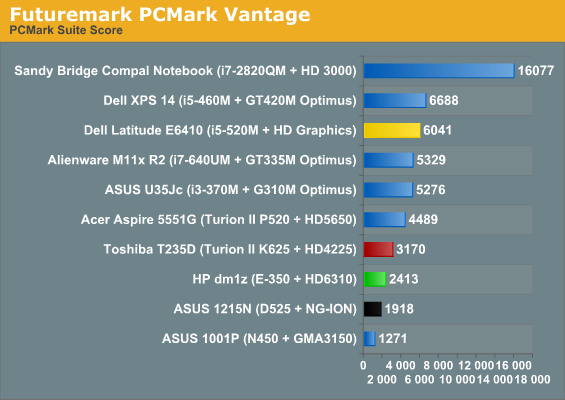
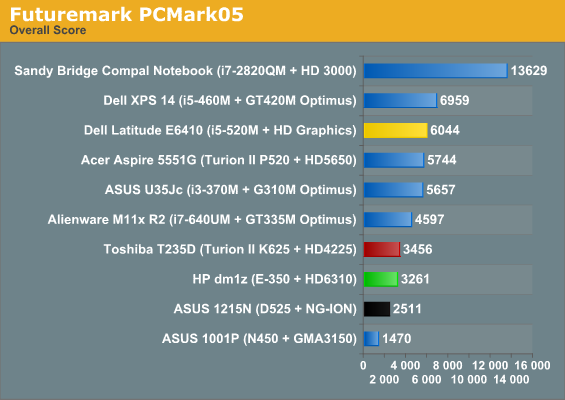
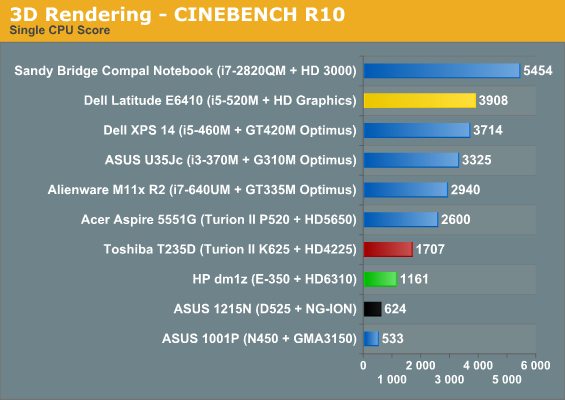
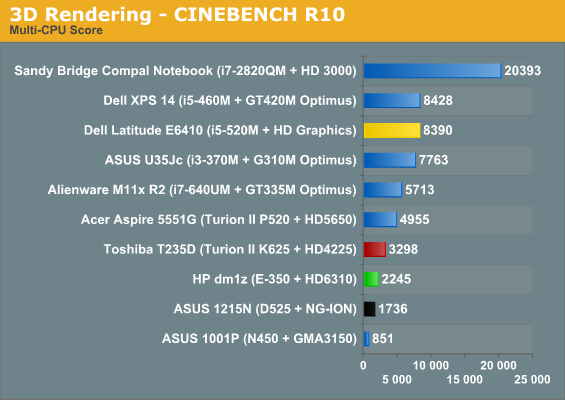
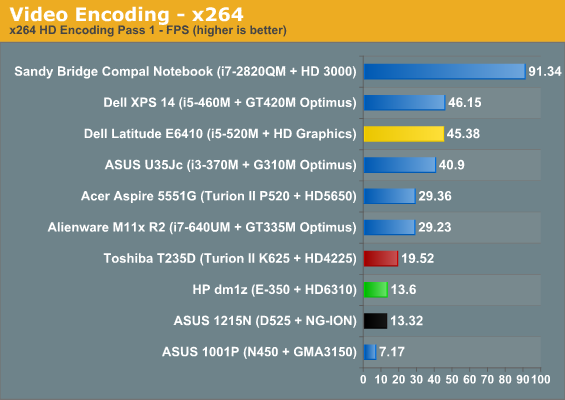
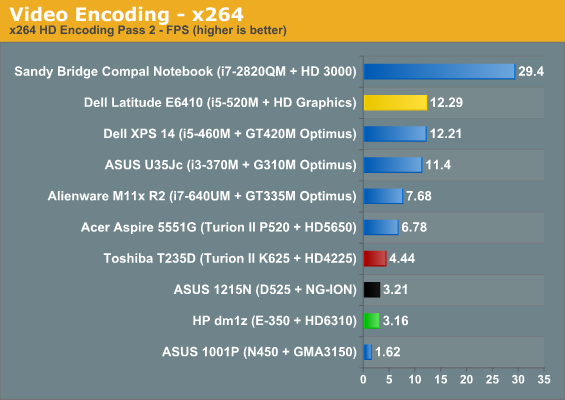
The first thing you'll notice is that while the E-350 generally cleans Atom's clock (the dual-core nettop D525 only comes out with a slight lead in the 2nd pass x264 encode), it's also generally about two-thirds as fast as the Nile platform's 1.5GHz Turion II K625. That's not too bad, but this is part of what Jarred's talking about, especially when you think about the Intel Core 2-based CULV kit that periodically kicks around the market (becoming stunningly rarefied). CULV hardware has also floated around the price point the dm1z is hitting shelves at, too, but it was fairly inconsistent. On the flipside, it does beat dual-core Atom equipped with NVIDIA's NG-ION, and this is a trend that's going to continue.
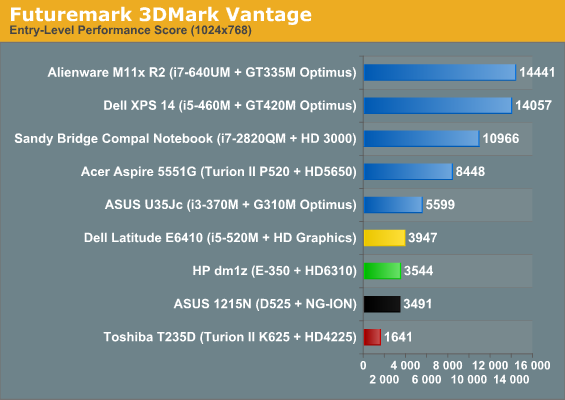
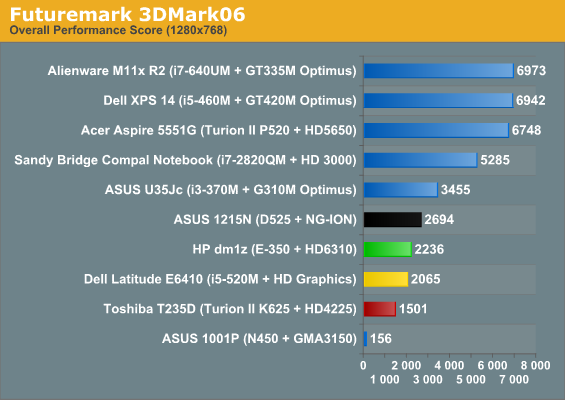
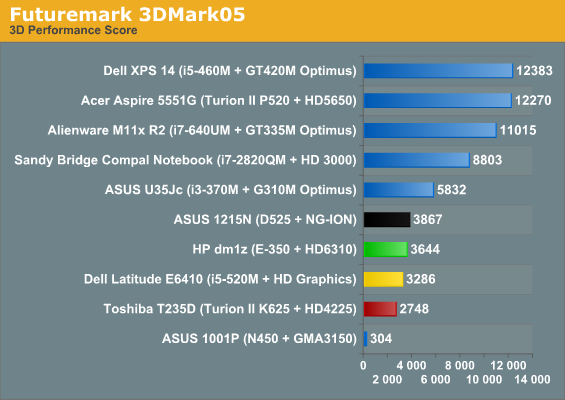
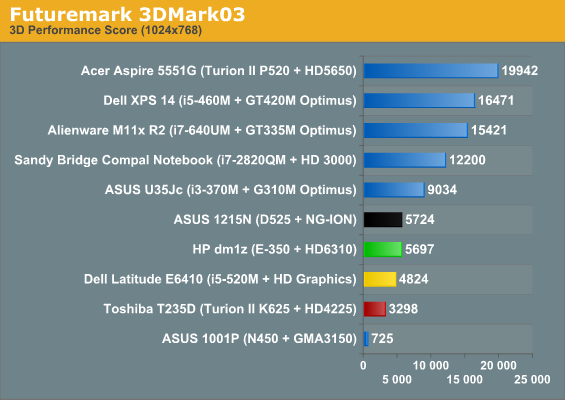
In 3DMark the E-350's integrated Radeon HD 6310 generally hangs out in the neighborhood of NG-ION, but it soundly beats Intel's last generation IGP (with better drivers and more stable performance to boot), and embarasses the Nile platform's Radeon HD 4225. That's not too surprising: in terms of raw GPU power the HD 6310 features twice the number of stream processors and a higher core clock.
If anything, the HD 6310 shows just how long in the tooth AMD's current IGP has really gotten: when it debuted as the 780G, it was a revelation, offering the best IGP performance bar none. The problem is that AMD just let it sit, offering new model numbers with no real performance increase outside of adding DirectX 10.1 support and bumping clocks slightly in some cases while serving us a warmed over Radeon HD 4550 in the form of the Radeon HD 5450 when they really should've just been integrating that hardware into their chipsets.
Ah well. With Brazos here now and Llano on the horizon, the era of AMD integrated graphics parts wearing out their welcomes should come to a close.










108 Comments
View All Comments
ganeshts - Monday, February 21, 2011 - link
Not only is AMD late to the party, it is trying to come in after closing time!With the tablet craze about to take off following the year of the iPad, I am not even sure people want to throw away their money on anything so anaemic and running Windows...
JarredWalton - Monday, February 21, 2011 - link
Boo! Down with the naysayers! I'm honestly not really interested in tablets. They're fun gadgets to show things to people, but typing on them sucks. Add a separate keyboard, and now you're lugging around a laptop equivalent (that's still slower than any netbook, only with a somewhat optimized OS).Brazos finally makes netbooks viable as an overall computing platform. 7+ hours of battery life, performance that's substantially better than Atom (particular Atom on its own), and a reasonable cost. Maybe you'll get some decent HTPC setups with Brazos now... though honestly, I think for serious HTPC stuff like you test, you'll need something clocked quite a bit higher than the E-350's 1.6GHz.
StevoLincolnite - Monday, February 21, 2011 - link
I concur, I'm not interested in tablets running a mobile OS and ARM either.I've actually got myself a convertible netbook running Windows 7, I use it more in a laptop mode than a tablet mode.
I've got friends with an iPad and they say crazy things like: "It's changed my life!" (Really? It's just an over-sized iPod.)
The annoying part about Tablets I find is how bloody awkward they are to hold when you are sitting at something like a table where they can't hold themselves up and typing is well... Slow.
I say bring on Fusion, more performance at the low end is a good thing, just wish these manufacturers would start putting decent screens in mobile PC's.
mgl888 - Monday, February 21, 2011 - link
+1Tablets feel more like amusement devices at the moment. Without a keyboard and your standard applications, you really can't get much "work" done.
Rick83 - Tuesday, February 22, 2011 - link
A 5 inch tablet is so much more carryable and hence useable than a netbook, it's not even funny. The only netbook that really is worth any consideration is the insanely priced sony Z/V/P? series...the one with the 1600x768 screen.Cheap computing isn't really worth the trouble...
And as long as I need a separate bag to carry my on-the-go computer, it's really a no-go.
Visual - Tuesday, February 22, 2011 - link
Eh? A 5 inch tablet is almost insignificantly more usable than my 4 inch phone. It is redundant.Rick83 - Tuesday, February 22, 2011 - link
Actually, 5 inch is quite a bit larger than the 4" phone. It is the largest universally pocketable size I found, and I actually have a non-smart-phone (S40 based) so that some software issue won't shut me out from telephony (bodged firmware update still did exactly that even on the S40....) and so that I wont have to hold a giant screen thing to my ear, and have access to my organizer/internet while on the phone....Plus, my 5" tablet has suport for keyboard via bluetooth or usb, it has a mini-hdmi output which goes up to 720p, all of which is quite hard to find on a 4" phone.
And the screen surface is almost 50% larger. (20% in the diagonal should be 44% of the area) This makes reading much more comfortable. Also, the relaxed size and lack of 3G allow a higher power envelope for the SoC resulting in better performance.
acsa - Tuesday, February 22, 2011 - link
Amusement? It is very annoying to hold a tablet all the time during playing, movie watching, browsing, reading while sitting on any comfortable furniture. Even a 5 lbs brick on the lap is better. But even for sharing anything with others (also working thogether), while sitting at a desktop, a "standing-up" netbook/notebook is still much more comfortable. Of course, the are specific areas where the interface itself is very useful but at recent stage of software services I don't see many. And partial it is useful for portability if you have a lot of other luggage always carrying with you by foot. But that's again rare. Maybe where lack of cars and public transport is significant ;)FunBunny2 - Tuesday, February 22, 2011 - link
Until "pickable" apps are written for tablets, they won't really do much. The issue is whether developers will figure out how to data model "pickable" apps. RDBMS will do that, but most developers aren't smart enough.Powerlurker - Tuesday, February 22, 2011 - link
That's probably true, but I don't see how that's too big of a problem. Most consumers don't go home and type reports in their free time.